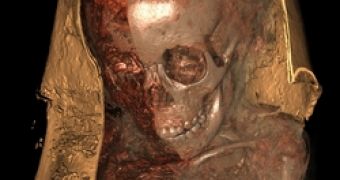Two thousand years ago in the sands of Egypt, grieving parents put their tiny child to rest in a way that was customary even during the time of Christ. They removed all of the youth's organs except for the heart, packed the remains in salt to cure them, and wrapped them in linen coated with perfumed resin. Like all Egyptians of the age, they were certain that their careful efforts would prepare their loved one to someday come back to life.
Today in Silicon Valley, a team of world-renowned experts proved those parents right - although the mummy's high-tech resurrection may not quite be what ancient Egyptians had in mind.
Curators at San Jose's Rosicrucian Egyptian Museum and Planetarium, which has housed the mummy since about 1930, have named the child Sherit, an ancient Egyptian name that means "little one."
For the project, radiologists at Stanford University School of Medicine used an AXIOM Siemens scanner, one of only five CT scanners in the world capable of producing such high-resolution images. Stanford Radiology's state-of-the-art scanner generated 2D slices as thin as 200 microns - several times thinner than the 750-micron slices used to create the popular 3D visualization of King Tutankhamen's mummy. In fact, at 92GB, Stanford Radiology's child mummy scans generated nearly 35 times more information than the scans conducted on King Tut.
To combine that information into a fully interactive 3D model of the entire mummy and its contents, researchers relied on the powerful Silicon Graphics Prism visualization platform with Intel Itanium 2 processors running VGL software from Germany's Volume Graphics GmbH. With Volume Graphics' real-time ray tracing technology - similar to that used to create hit animated motion pictures - researchers were able to generate a 3D model of incomparable quality and fidelity.
After conducting detailed analyses of several areas - including the hands, teeth, feet, skull, groin, spine and chest plate - researchers were able to arrive several conclusions about the mummy. Among them:
Sherit was a female who was between 4? and 5? years old when she died; Her remains show no signs of injury, which suggests she likely died from a common intestinal illness or other disease (in fact, half of all Egyptian children died before their fifth year); and Scented resin was mixed and applied on the mummy's golden face mask, a sign that her family was wealthy.

 14 DAY TRIAL //
14 DAY TRIAL //